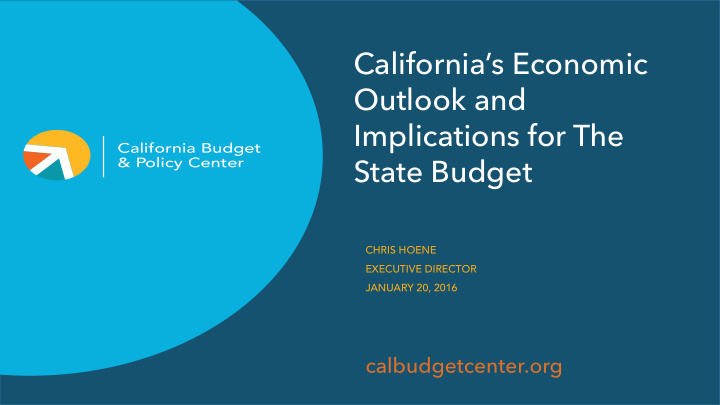



California’s Economic Outlook and Implications for The State Budget CHRIS HOENE EXECUTIVE DIRECTOR JANUARY 20, 2016 calbudgetcenter.org
The Current Economic Recovery: Slow and Uneven Improvement Following a Steep Downturn | 2
California’s Economy Continues to Improve • California’s current unemployment rate: 5.7%. • This is less than half of what it was during the worst of the Great Recession (12.2% in 2010). • Before the Great Recession began, California’s unemployment rate was 5.4%. | 3
It Took Much Longer to Regain the Number of Jobs Lost in the Great Recession, Compared to Other Downturns Percent Change in Total Nonfarm Jobs in California Since Each Recession Began 12% Early 1990s 10.4% Recession 2001 Recession 8 Great Recession 5.2% 4.2% Percent change at 0 = 4 point at which jobs lost in a recession are recovered 0 -4 -8 -12 0 5 10 15 20 25 30 35 40 45 50 55 60 65 70 75 80 85 90 95 100 Months Since Recession Began Note: The 2001 recession includes data up to July 2007, the month the Great Recession began in California. Source: US Bureau of Labor Statistics | 4
Only High-Income Households Have Seen Their Incomes Recover From the Great Recession Percent Change in Income Segment’s Average Inflation-Adjusted Income, 2006 to 2014 1.3% -3.4% -6.7% -10.0% -14.7% Bottom Second Middle Fourth Top Fifth Fifth Fifth Fifth Fifth Source: US Census Bureau | 5
Wages for All but the Highest-Paid California Workers Remained Below Their Pre-Recession Levels in 2014 Percent Change in Inflation-Adjusted Hourly Wage Between 2006 and 2014 5% 4 3 2 1 0 -1 -2 -3 -4 -5 -6 -7 -8 10th 20th 30th 40th Median 60th 70th 80th 90th Percentile Percentile Percentile Percentile Percentile Percentile Percentile Percentile Note: Data are for workers ages 25 to 64. Source: Budget Center analysis of US Census Bureau data | 6
Poverty Remains One of California’s Largest Challenges | 7
California’s Poverty Rate Remains High Even as the State’s Jobless Rate Has Fallen Substantially California’s Poverty and Unemployment Rates 25% Poverty Rate Unemployment Rate 20 16.4% 15 12.4% 10 7.5% 4.9% 5 0 2006 2007 2008 2009 2010 2011 2012 2013 2014 Source: Employment Development Department and US Census Bureau | 8
Nearly 1 in 6 Californians and More Than 1 in 5 California Children Lived in Poverty in 2014 Percentage of Californians With Incomes Below the Federal Poverty Line 25% Child Poverty Rate Poverty Rate 22.7% 20 17.3% 16.4% 15 12.4% 10 5 2006 2007 2008 2009 2010 2011 2012 2013 2014 Source: US Census Bureau | 9
There Are as Many Californians in Poverty as There Are Residents of the State’s Three Largest Cities Millions of People 8M 7 6.3 6.3 6 San Jose 5 San Diego 4 3 Los Angeles 2 1 Number of Californians in Poverty Number of City Residents Source: Department of Finance and US Census Bureau | 10
Poverty Rates Remain High in Many Parts of the State, Even in Places Where Job Gains Have Been Strong Percentage-Point Difference in Poverty Rate Between 2007 and 2014 | 11 Source: Budget Center analysis of US Census Bureau data
Many Californians Struggle to Make Ends Meet | 12
A Large Share of Low-Income Californians Struggle to Pay the Rent in Nearly Every County Share of Low-Income Renters Paying More Than Half of Their Income for Housing Note: Low-income households are those whose incomes do not exceed 80 percent of the median family income for the area. | 13 Source: Center on Budget and Policy Priorities
Implications for the State Budget and Education Spending? | 14
California’s Per Student Spending Has Gained on the Rest of the US, but Still Lags Gap Between California’s K-12 Spending Per Student and the Rest of the US $0 -500 -$770 -1,000 -$975 -1,500 -2,000 -2,500 -$2,675 -3,000 02-03 04-05 06-07 08-09 10-11 12-13 14-15* * 2013-14 and 2014-15 data are estimated. Note: Figures are in 2014-15 dollars. | 15 Source: National Education Association
The Gap Between California's K-12 Spending and That in the Rest of the US Has Narrowed Since 2012-13 K-12 Spending as a Percentage of Personal Income 4.5% Rest of the US California 4.04% 3.97% 4.0 3.94% 3.88% 3.5 3.48% 3.0 3.07% 2.5 02-03 04-05 06-07 08-09 10-11 12-13 14-15* * 2013-14 and 2014-15 are estimated. Source: National Education Association and US Bureau of Economic Analysis | 16
California’s Support for K-12 Education Ranks Low by Almost Any Measure | 17
How Does California's Support for K-12 Education Compare? Rank California US Source Spending Per Student K-12 Spending Per Student National Education Adjusted for Cost of Living 42 $10,139 $12,040 Association (NEA) and (2014-15)* Texas A&M University Spending as a Share of the Economy K-12 Spending as a NEA and US Bureau of Percentage of Personal 36 3.48% 3.88% Economic Analysis Income (2014-15)* Staffing Ratios Number of K-12 Students 51 22.4 15.5 NEA Per Teacher (2014-15)* Number of K-12 Students National Center for Per Guidance Counselor 51 785 440 Education Statistics (2011-12) (NCES) Number of K-12 Students 51 7,572 958 NCES Per Librarian (2011-12) * Data are estimated. Note: All figures reflect Budget Center calculations. | 18
1107 9th Street, Suite 310 Sacramento, California 95814 916.444.0500 choene@calbudgetcenter.org @ChrisWHoene @CalBudgetCenter calbudgetcenter.org
Recommend
More recommend